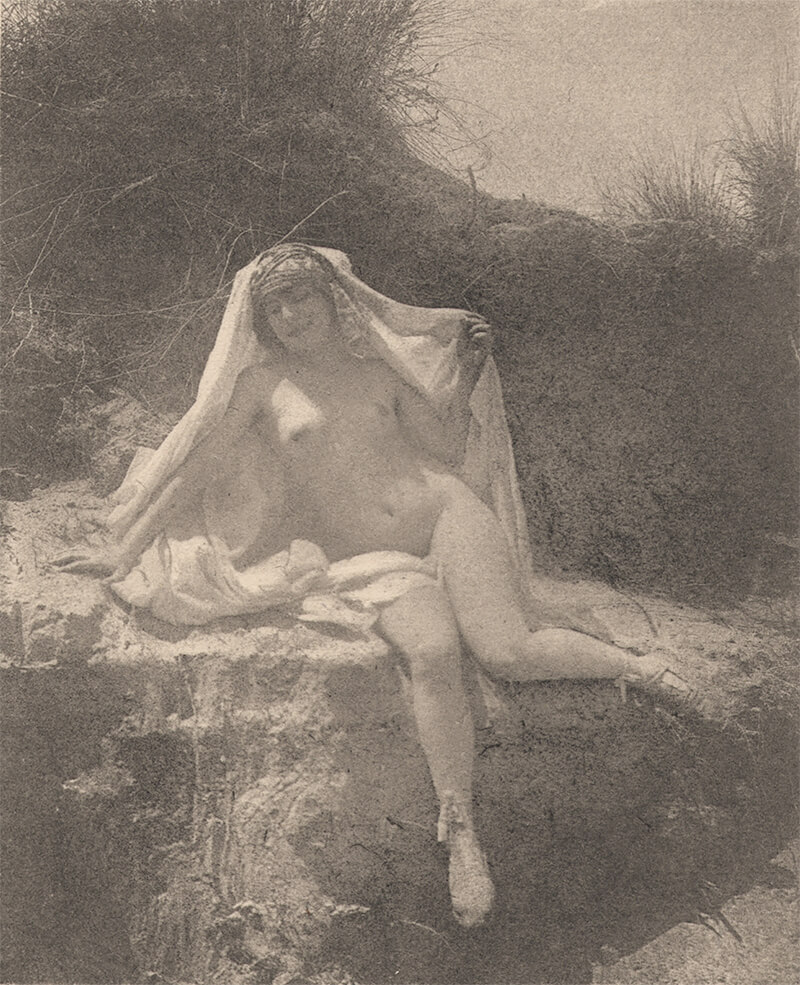
Why does the human body spark so much interest?
Why are magazines, newspapers, films and ads… full of images of naked or partially naked bodies?
Why are so many writers, artists in general and photographers in particular so often inspired by nudity? The representation of the human body became a classic exercise in fine art, and the nude has always been of particular interest to artist since the very beginning.
Some photographers know that their work can propel them into endless criticism about their representation of the human body. Storms of controversy greeted many projects for years. It is always the perception of a transgression of conventional representations of the body that sparks the flame, especially notions related to sexuality.
Photography has had a profound impact on the evolution of the perception of the body for more than a century. It has fully contributed to the exploration of human anatomy and morphology, as well as to the collective erotic imagination.
This article showcases essential photographers spanning from the 19th century to the present day, illustrating the evolution of nude photography through the talent of prominent artists.
Pioneers
The nude, an ancient tradition among the consecrated arts, has struggled to gain recognition or even the right to feature as a photographic genre for a very long time, although it is probably as old as its invention.
Some ‘righteous people’ at the time excluded even the hypothesis of its existence, even when medical oriented images where commonly accepted.
Despite the fact that photographers at the time, often trained painters, reproduced the postures of classical paintings and ancient sculptures (they had a predilection for an academic approach), photography shocked because of its realism. It was thought to desecrate artistic convention, criticized for not showing naked goddesses, but simply undressed women.
Auguste Belloc (French 1800-1867)
Auguste Belloc
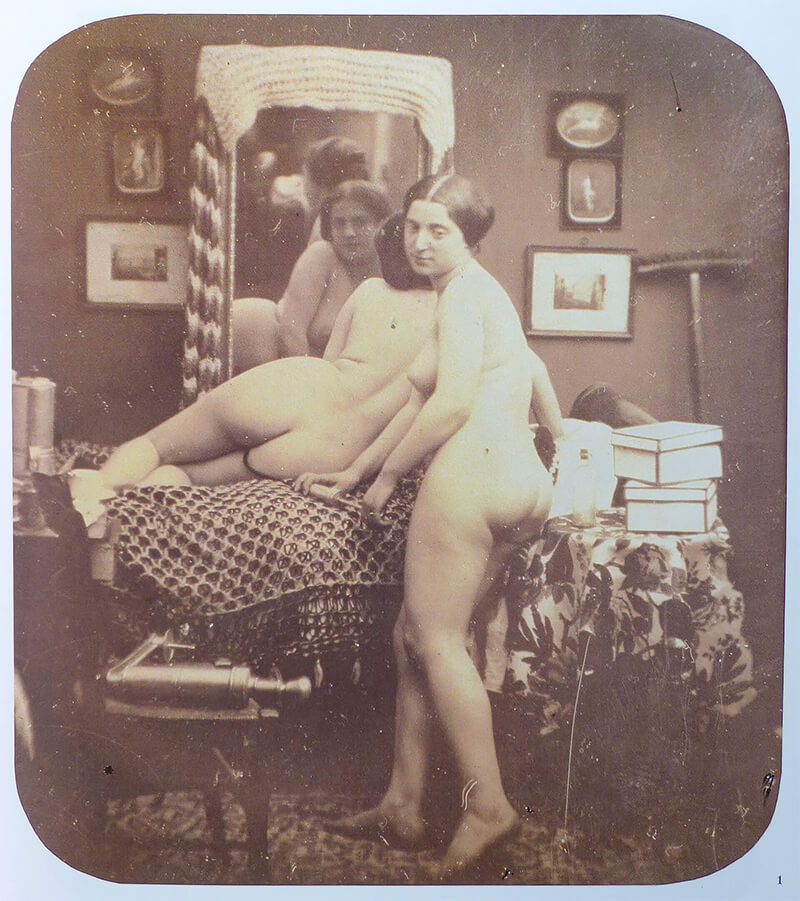
A stereoscopic daguerréotype depicting two nude women looking into a mirror © Auguste Belloc
Auguste Belloc took some 5,000 nude photographs (some delicately colored by hand), that were seized by the police in 1856. Belloc was sentenced to three months in prison and the images were transferred to the Bibliothèque Nationale.
Nadar (French 1820-1910)
Nadar
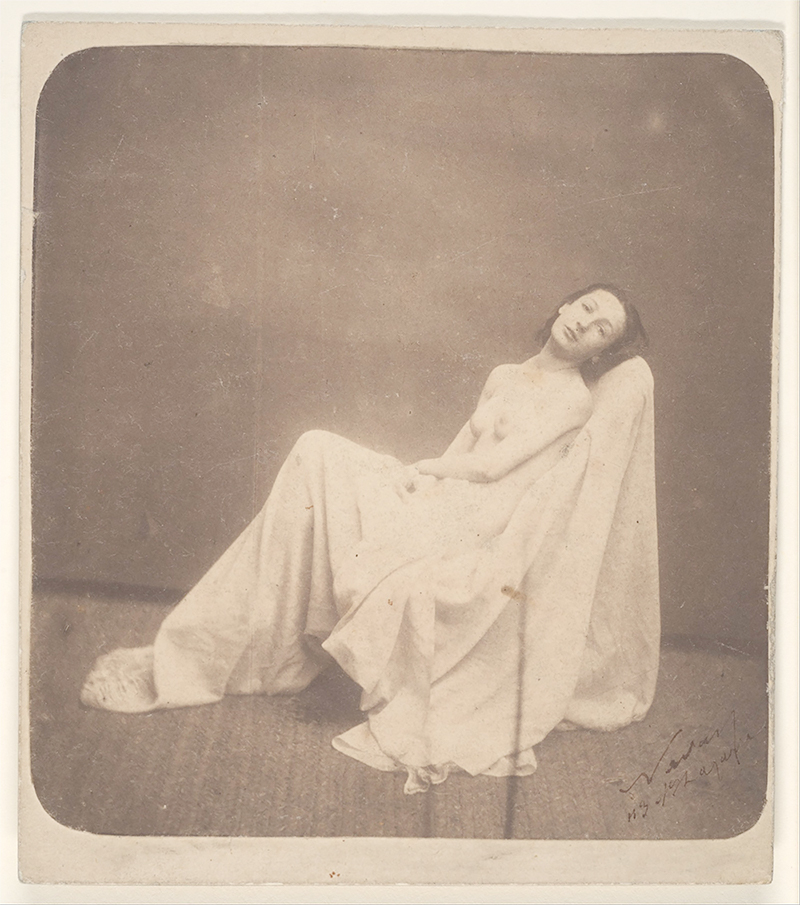
Seated Model, Partially Draped 1856-1859 © Nadar/MET
This photograph traditionally has been associated with Scènes de la vie de Bohème, stories by Henri Murger based on the lives of his friends. The character Mimi, a girl of easy virtue, owed much to Murger’s girlfriend Lucille, who died of consumption. Although we cannot know whether this unique print portrays Lucille, the easy attitude of the woman’s pale thin body and her beguiling regard confirm her membership in the sorority of Mimis.
Source: The MET
Gaudenzio Marconi (Swiss/Italian 1842-1885)
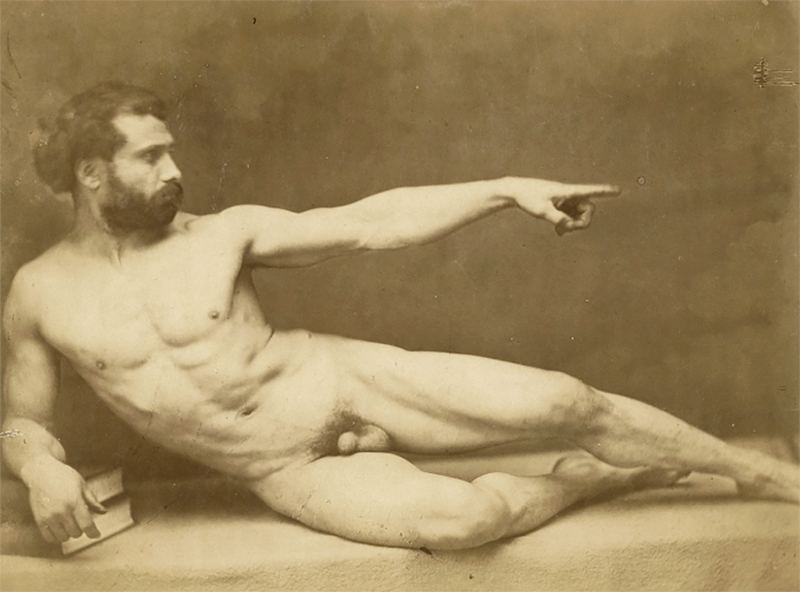
© Gaudenzio Marconi
In 1868, Gaudenzio Marconi took over the studio of Auguste Belloc. Marconi is mentioned in the Parisian phone book under the name ”Official Photographer of the School of the Beaux Arts”. His photographs were used by artists like Auguste Rodin.
Alfred Stieglitz (American 1864-1946)
Alfred Stieglitz
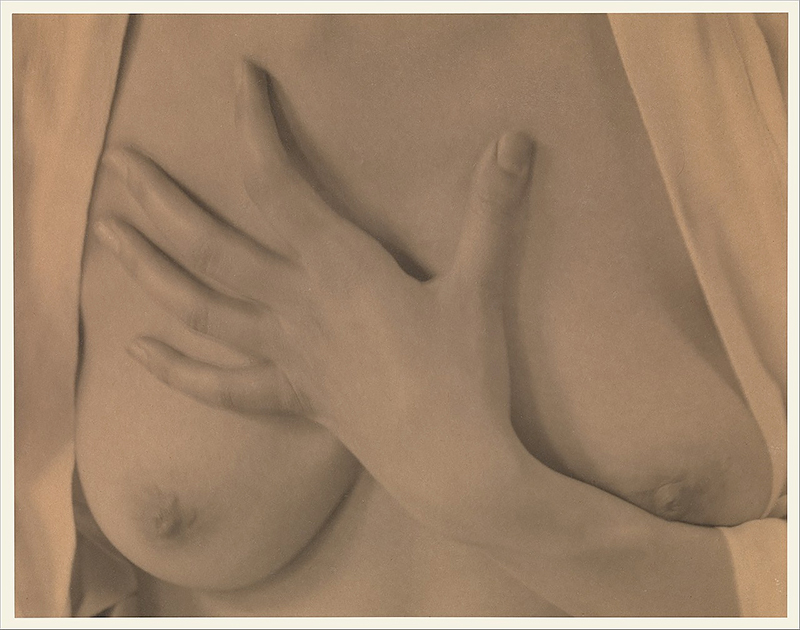
Georgia O’Keeffe, Hand and Breasts 1919 © Alfred Stieglitz, MET DP232920 CCO
A key figure in the New York art scene of the early 20th century, Alfred Stieglitz fell under the spell of Georgia O’Keeffe, who was 23 years younger than him, in 1916. An intense passion started and he photographed his new muse from all angles, with an erotic tension that does not thwart the aesthetic options of the new circle: to refuse the ambient puritanism and to favor an American art. Georgia’s face was captured up close, as were her hands, her body, where Stieglitz managed to emulate his own desire. He photographed her in her nudity, always seeking to capture her mystery; her hands form a kind of ballet, her buttocks molded under wet cloths suggest a tension more erotic than any other realistic shot…
Imogen Cunningham (American 1883-1976)
Imogen Cunningham
Imogen Cunningham liked nude photography and she experimented a lot and it was shocking. She took some of her negatives out of the public eye for over 50 years. She photographed naked bodies of both men and women, which at the time was completely incongruous and unacceptable. She liked to work with bodies like paintings, bringing out the shapes. Anonymous and sublime, these body ‘portrait’s are of fabulous simplicity and purity.
Man Ray (American 1883-1976)
Man Ray
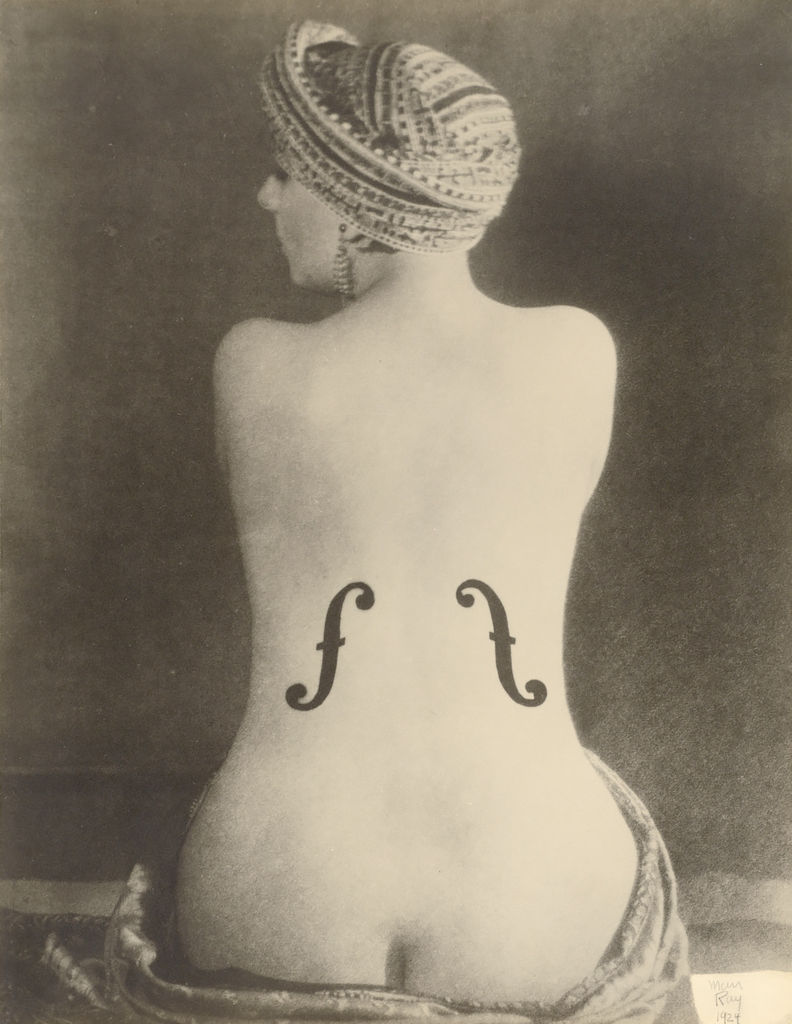
Le Violon d’Ingres (Ingres’s Violin), 1924 © Man Ray
The body of a woman was for him only an object and he treated it with the same curiosity, with the same coldness as a crystal or a porcelain. The motif, the curve, the play of shadows and lights amused him. His nudes were often more mutilated than antique statutes; an arm, a breast are beautiful? So you had to grab them, put them on the film. No study, no preparation, he was content to catch the fleeting moment. In this photographic search for the picturesque, the amusing, beauty in itself, he forgot his personality, he willingly sacrificed an ensemble to a single detail that seduced him. He liked the vigorous lighting which cuts out the forms with brutal clarity, emphasizing the volumes and allowing clashing oppositions.
Sasha Stone (Russian 1895-1940)
Sasha Stone
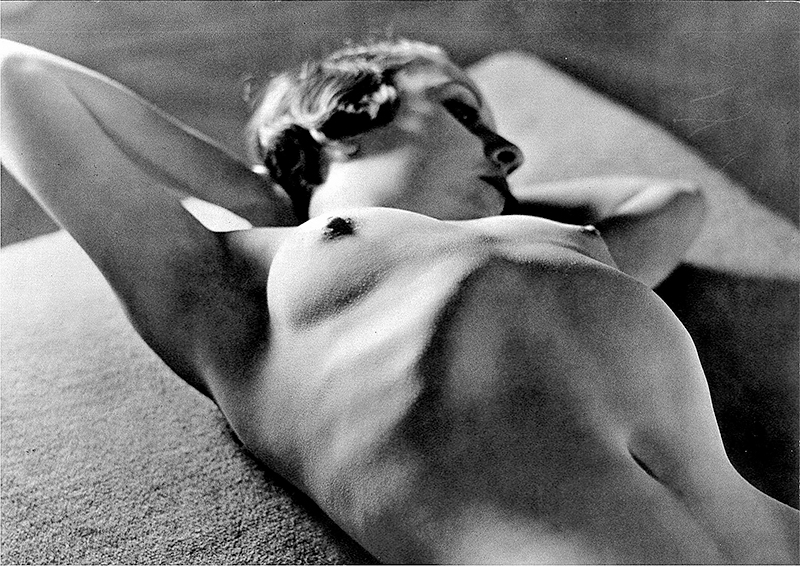
Nude from Sasha Stone’s book Femmes, Paris, Arts & Métiers graphiques, 1933. © Sasha Stone
Sasha Stone took twenty-five photographs of women in 1933. For this project, he chose to set aside professional models in order to free himself from the image of the clichés of women of this period and focused on the details and gestures of contemporary women.
Paul Outerbridge (American 1897-1969)
Paul Outerbridge
A pioneer of color photography, this master of studio photography is the author of nudes that caused scandals in his time. Strongly influenced by surrealism, his work combines the sophistication of the composition with a fetishistic eroticism. Carried by amazingly realistic color prints, his images drew their inspiration from ancient Greece, the Bauhaus school or the theme of Narcissus. Insidiously, the naked bodies of Outerbridge fit into an erotic scenario focusing on lust, exhibitionism and voyeurism. ‘Virtues’ critics will assimilate the completely carnal beauty of the models ,aware of their triumphant femininity, as a provocation, even perversion. A violent polemic animated by Puritan spirits broke out.
Germaine Krull (German 1897-1985)
Germaine Krull
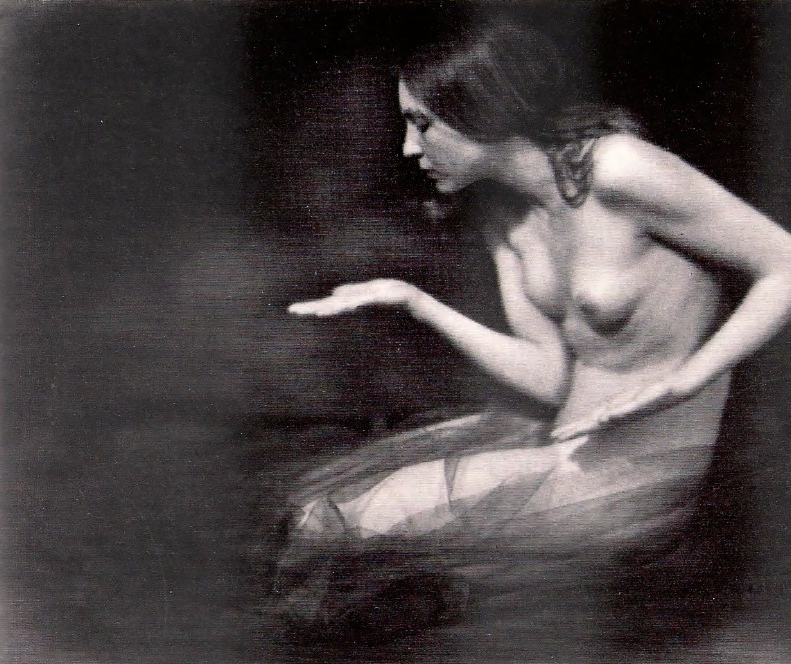
Erotische Fotografie 1890-1920 © Germaine Krull
Germaine Krull was a pioneering photographer who played a significant role in the development of modernist photography in the early 20th century. She was known for her innovative use of perspective, light, and angles to capture striking and dynamic images. In the years following World War I, an increasing number of professional female photographers claimed subjects traditionally generated by and for men. Among the most personally and creatively independent, Krull drew inspiration from the permissive cabaret culture she had enjoyed in Berlin in the early 1920s. Between 1922 and 1924, Krull published two portfolios of work, “Atke” (“Nudes”) and “Les Amies” (“Girlfriends”): the former a playful collection of sultry poses, and the latter an explicit series of a lesbian encounter. Though Berlin was a progressive city, Krull’s work teetered on the city’s legal line between obscenity and art. Her nude photographs were characterized by their powerful and erotic composition, and they often depicted women in a way that challenged traditional gender roles and expectations. She incorporated dramatic lighting and disorienting viewpoints in her studies.
Erwin Blumenfeld (German/American 1897-1969)
Erwin Blumenfeld
Erwin Blumenfeld was a German photographer who gained fame for his innovative fashion photography and avant-garde approach to image-making. He began his career in the 1930s in Paris and quickly established himself as a leading photographer, working for Vogue, Harper’s Bazaar, and other prominent publications. Blumenfeld also experimented with nude photography, using his signature surrealistic and experimental style to create powerful and provocative images of the human body. His nude photographs often featured unusual poses, compositions, and lighting, creating a sense of mystery and intrigue. He aimed to persuade his audience of the magical beauty of the female form, and to show the world that the nudes of the great master painters–from Botticelli to Ingres–could be challenged by the magical potential of the darkroom. Blumenfeld was an inspired innovator who experimented with solarizations, reticulations, negative-positive combinations, and chemical manipulations to enhance the mystery of his images. He was known for his ability to capture the essence of his subjects and to create images that were both sensual and elegant.
George Brassaï (Hungarian/French 1898-1984)
George Brassaï
George Brassaï was a Hungarian-French photographer who is best known for his night-time photographs of Paris and his portraits of artists and intellectuals. While Brassaï is not typically associated with nude photography, he did create a series of erotic images in the 1930s, many of which featured nude or partially nude women. Brassaï transformed the female nude body into geometrical lines, curves and shapes, suggestive of its corporeality. He focused on the woman’s torso twisted at an angle to reveal the outline of her hip, waist, and breast. The woman’s head and legs are cropped, and the twisted angle of her torso makes her body seem like a floating organic form. Brassaï contributed about 150 nude photographs to the magazine Minotaure over a decade. The female nude may have been a subject he dealt with extensively in his drawings and sculptures, but his headless nudes held special appeal for the Surrealists. Without heads or with reduced heads, as the art historian Sidra Stich observed, the figures no longer offer evidence of their superior human status.
André Kertész (Hungarian 1894-1995)
André Kertész
Photographer André Kertész, who was born in Hungary, was best known for his lyrical, elegant, and strictly exacting aesthetic. One of the most creative photographers of the 20th century, Kertész is revered most likely for the way he tested the limits of the new Leica handheld camera, even though he subsequently worked with other formats, including Polaroid. Kertész, who promoted spontaneity over technical precision – ”photographs can be technically perfect and even beautiful, but they have no expression” he once said – created a highly distinctive body of work that reflected his commitment to poetic and geometric forms. Kertész’s nude photographs often featured his wife, Elizabeth, as his model. His images were characterized by their minimalist compositions and use of natural light, creating a sense of intimacy and vulnerability. Kertész’s nude photographs were not overtly sexual or provocative, but instead celebrated the beauty and grace of the human form. The series ‘Distortion’ was made in the early 1930s. Clearly showing the influence of the Surrealists, Kertesz created these photographs by capturing the reflections of a female nude figure in a convex or concave mirror. The work builds on his awareness of the visual effects of distortions demonstrated in his early 1917 photograph of a swimmer underwater. The series was taken in a studio, which is unusual amongst Kertesz’s practice as he more often than not used a documentary style of photography on location.
Edward Henry Weston (American 1886-1958)
Edward Henry Weston
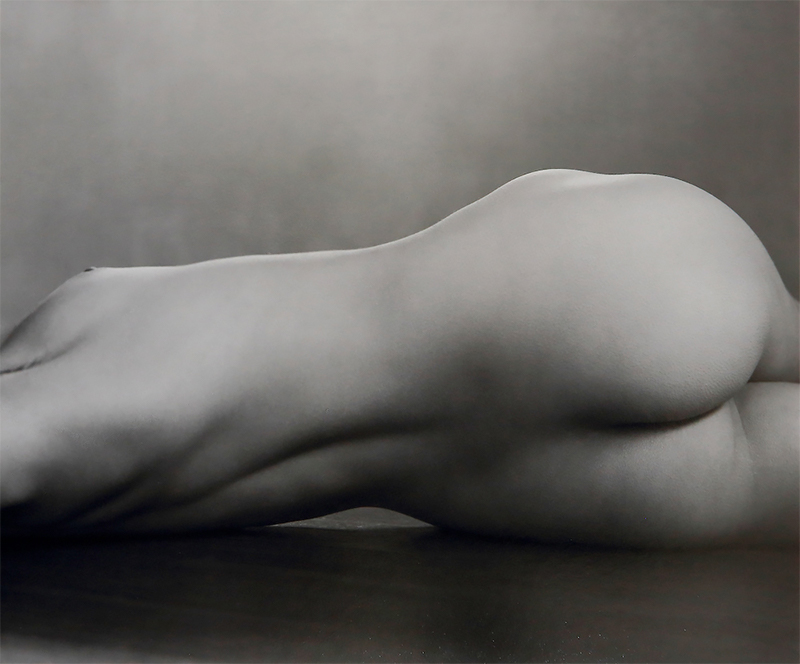
Nude, 1925 © Edward Weston
Weston began photographing nudes – his largest series of close-up organic forms – in the early 1920s and continued over the next twenty years. Models included friends, family, and most frequently, his lovers. While the body of this figure is not entirely exposed, nudity is implied by its inclusion in the series. The subject is seated with legs folded under and slightly askew, exposing knees and thighs, one in front of the other. Common among Weston’s work at the time, his cropping and dramatic lighting create a high contrast image that encourages focus on the fleshy bumps and curves of the female form. Many of Weston’s most famous nude images depict his muse and assistant Charis Wilson, whom he met at a concert in April 1934 and described as a “tall beautiful girl, with a finely proportioned body, intelligent face well-freckled, blue eyes, golden brown hair to the shoulders”. The New York Times critic Hilton Kramer wote, ”To Weston’s eye… the landscape of the human body was an unending revelation of forms both voluptuous and abstract. His genius as an artist lay in his ability to respond to both with equal passion”
Wynn Bullock (American 1902-1975)
Wynn Bullock
Wynn Bullock was a photographer whose singular and enigmatic works are charged with a psychological and philosophical profundity that mirrored his lifelong quest for the meaning of life. Bullock experimented with alternative processes like solarization in his early work, which was influenced by the work of Man Ray and Lázsló Moholy-Nagy. However, a meeting with Edward Weston in 1948 changed his direction, and he would spend the ensuing decades producing the body of work for which he is best known. His landscapes, seascapes, and nudes from this time are notable for their realism and tonal loveliness as a result of his immersion in nature.
”For me a nude photograph should be erotic, not devoid of emotion. The body is a sensual thing, sensuality being one of its most beautiful and meaningful qualities.”
— Wynn Bullock
Herbert List (American 1903-1975)
Herbert List
Herbert List was a German photographer, who worked for magazines, including Vogue, Harper’s Bazaar, and Life, and was associated with Magnum Photos. His austere, classically posed black-and-white compositions, particularly his homoerotic male nudes, taken in Italy and Greece being influential in modern photography and contemporary fashion photography.
Similar to numerous homosexual photographers of that period, Herbert List found a fascination with the unclothed male physique. In contrast to the 19th-century artistic trend, particularly the revival of neoclassicism, which glorified the nude female body, Herbert List emerges as a trailblazer, alongside figures like Paul Horst, George Platt Lynes, Man Ray, and Raymond Voinquel, in his pursuit of young male models. His interest in antiquity and his journeys through Italy and Greece inspired him to capture in the poses of his models a grace reminiscent of stone representations. List’s depictions of men distinguish themselves from Baron Van Glœden’s work. Herbert List’s concealed male figures allude to the mineral essence of ancient ruins, akin to restoring humanity to marble sculptures frozen in their polished purity by the passage of time. However, List, diverging from the warrior and virile imagery, follows a nuanced path—embracing purity and sensuality, playfulness and camaraderie over confrontation. His photographs of Greece and Italy mirror the activities of young men on the North Sea beaches, creating a fusion between a vanished era and the contemporary moment. The male form takes a central role in Herbert List’s artistic endeavors.
Herbert List never exhibited his photos during his lifetime. He stored them under a cupboard in what he called his poisoned chest. Like many other photographers and painters of his generation, List was aware of the taboos surrounding the representation of the male nude. It would take until 1988, thirteen years after his death, for the first book, Junge Männer (1988) which contains more than seventy images of young men lounging in the sun, wrestling and innocently regarding the camera lens to be published. He, who in the late thirties fled Germany due to the persecution faced by homosexuals, preserved throughout his life the concern to protect an essential part of his life and work.
Bill Brandt (German/British 1904-1983)
Bill Brandt
Bill Brandt made a place for himself as one of the most prominent photographers in Britain over the course of the twentieth century. Beginning as a photojournalist, Brandt produced a wide range of work throughout his career, including portraits, landscapes, and nudes, done entirely in black-and-white. In his naked state, which he first began experimenting with in the 1940s, Brandt produced some of his most imaginative work. Here is where the photographer really discovered their unique style of composition, gradually turning the nude subjects into abstract, jumbled, and formally ambiguous forms that they hardly resembled human beings anymore and contrasted or blended in with the surroundings in the most unexpected ways. To create his nude photographs, Brandt collaborated with professional figure models, fashion models, and acquaintances or family. Photographed at coastal locations in Normandy and Sussex, Brandt started working on the extensive collection of nudes that makes up Perspective of Nudes in the 1950s. He began shooting stones on the beaches and close-ups of female body parts, resulting in an interplay of round shapes and occasionally even beggining the question of which is which. These were fragmented nudes. He showcased many facets in his artistic career: the diffusion of a landscape aesthetic into the human form, his innovative darkroom techniques, and his disruption of the classical nude with hints of surrealism. Highly abstract and aesthetically engaging, Brandt’s nudes are a timeless constituent of twentieth-century photography.
”A good nude photograph can be erotic, but certainly not sentimental or pornographic.”
— Bill Brandt
Ruth Bernhard (Germany / United States 1905-2006)
Ruth Bernhard
Ruth Bernhard started working in nude photography in 1934, the genre for which she would ultimately become famous as an image-maker. She was born in Berlin in 1905 and moved to the United States in 1927, where she was inspired by photographers such as Edward Weston early in her career. (who she met in California in 1935 and became friends with). Throughout her decades-long career, Bernhard’s work – often black and white Modernist nudes with a sensual, sometimes erotic, focus on the female body – was accomplished and praised. Bernhard’s nude photographs were notable for their simplicity and purity, often featuring her subjects in natural poses and settings. She used a range of techniques, including close-ups and extreme angles, to create images that were both intimate and abstract, inviting the viewer to contemplate the beauty and complexity of the body. Bernhard returned to the nude time and again during her career; her first monograph, published in 1986, was a collection of 50 nudes entitled The Eternal Body. Bernhard also used mirrors, frosted glass, shells, animal skulls, veils, and dolls in her tableaux to integrate Surrealist elements. These are dreamy and playful pictures. She was not scared to try new things.
Horst P. Horst (German/American 1906-1999)
Horst P. Horst
Horst P. Horst was a German-American fashion and portrait photographer who was known for his elegant and sophisticated approach to nude photography. He was a leading photographer of the 1930s and 1940s and his work had a significant influence on the fashion and photography industries. Horst’s approach to nude photography was characterized by his use of lighting, composition, and form to create images that were both sensual and timeless. He often photographed his subjects in classic, sculptural poses that emphasized the beauty of the human form, and his use of dramatic lighting created a sense of drama and mystery. Over time, Horst. P Horst honed a technique similar to Greek stature, literally shedding dramatic light on human curves. Horst’s male nudes were not as widely published or celebrated as his female nudes, but they were still notable for their technical excellence and their ability to capture the beauty and complexity of the male form. Horst’s contributions to the genre of male nude photography helped to expand the artistic and cultural appreciation of the male body as a subject of art and beauty.
Minor White (American 1908-1976)
Minor White
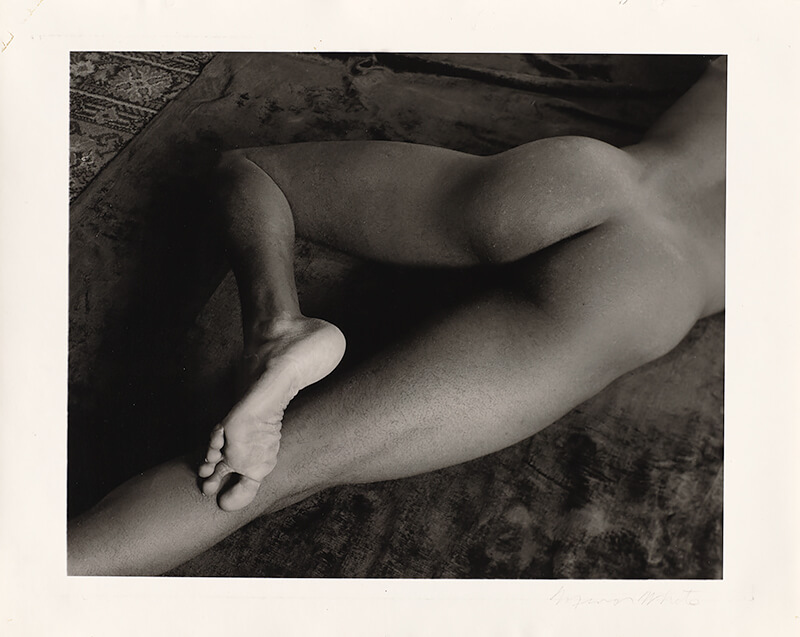
Nude Foot, San Francisco, March 23 1947, Gelatin silver print © Minor White
Courtesy The Minor White Archive, Princeton University Art Museum, bequest of Minor White (x1980-890) © Trustees of Princeton University
Minor White was an American photographer known for his poetic and introspective approach to photography, including his exploration of the nude form. White was interested in using photography as a means of exploring the deeper aspects of human experience, and his nude photography was often characterized by a spiritual and symbolic quality. White saw the nude form as a means of exploring the deeper aspects of the self (and is own homosexuality), and his photographs often had a meditative quality that invited viewers to contemplate their own spiritual and emotional states. White snapped pictures with more overt homoerotic content when no one was looking. In 1940, he created a number of art nudes featuring the model Gino Cipolla in the eerie manner of George Platt Lynes’s masculine nudes of the time. Additionally, White created beefcake portraits, a staple of physique magazines that functioned as covert erotica for homosexuals. Both environments favored underplaying the masculine genitalia. In this case, White aligned his art nudes with the norms of the female nude, treating the contoured (and hairless) body as a sculpture, while in the beefcake portraits, he used bodybuilders’ poses, which were themselves adapted from classical sculpture, frequently to kitsch effect. Although White would continue to take pictures of naked men in private throughout his life, his early years in Portland and San Francisco, from 1937 to 1953, saw the most of his attention focused on this topic. White’s masculine nudes from this time period are abundant and explicit, and they are from a time when the artist engaged in a lot of overt sexual activity. But more significantly, his embrace of the pervasive modernist notion that sex is the source of creativity—a notion White could only obliquely acknowledge—is manifest in his nudes. In a 1947 letter to Ansel Adams, White postulated that ”the basis of man’s art his soul, his heart, or his genitals . . . once they were all the same thing.” Cipolla, in White’s rendering, might be seen to resemble a Weston pepper, desexualized in equal measure to the vegetable’s eroticization. None of his male nudes were published in White’s lifetime.
Henri Cartier-Bresson (French 1908-2004)
Henri Cartier-Bresson
Although Cartier-Bresson is not generally associated with nude photography, he did create a series of nude photographs in the early 1930s. These photographs were not meant to be erotic or titillating, but rather were an exploration of the human form and its relationship to the natural world. In his book ”The Mind’s Eye,”Cartier-Bresson wrote about his approach to nude photography, saying: ”I’ve always been interested in the body, but not in a lascivious or voyeuristic way. For me, the body is a form, a volume, a geometry. It’s the architecture of our flesh, the structure of our being.” Cartier-Bresson’s nude photographs are characterized by their simplicity and elegance. He used natural light and simple compositions to create images that were both intimate and timeless. While his nude photographs are not as well-known as his documentary work, they are still considered an important part of his artistic legacy.
Harry Callahan (American 1912-1999)
Harry Callahan
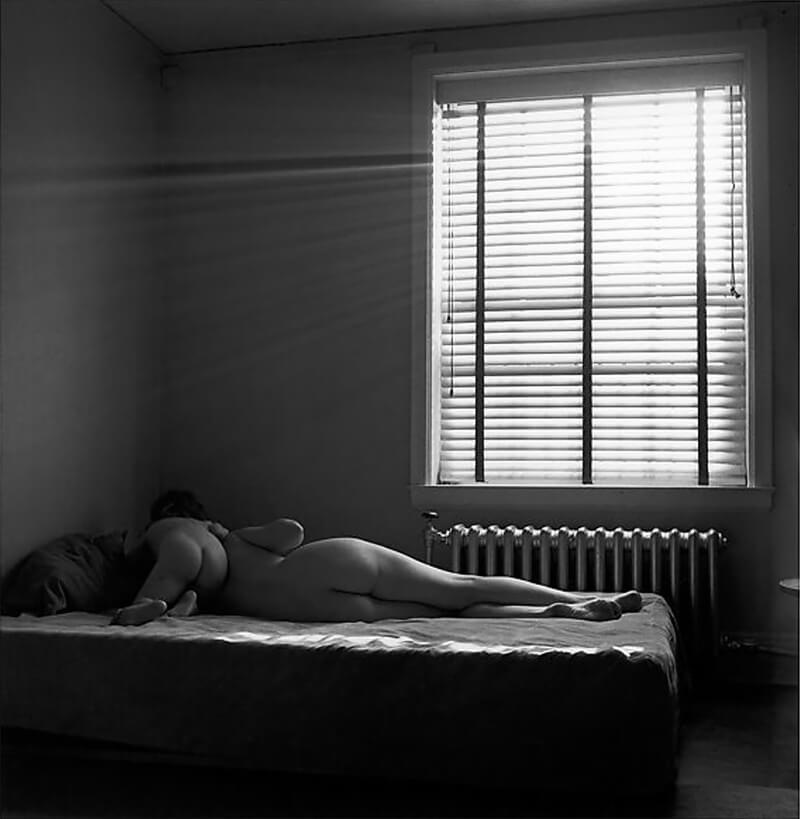
Eleanor and Barbara, Chicago 1954 © Harry Callahan Courtesy Pace/MacGill Gallery
Muses throughout his career, Callahan’s wife and daughter played, posed, and aged before his lens. With their attention to the physicality of light, however, Callahan’s photographs transcend mere family portraiture by calling attention to the simple beauty of life’s fleeting moments. ”He just liked to take the pictures of me,” Eleanor recalled in her nineties. ”In every pose. Rain or shine. And whatever I was doing. If I was doing the dishes or if I was half asleep. And he knew that I never, never said no. I was always there for him. Because I knew that Harry would only do the right thing.” Eleanor Callahan died in February 2012 at the age of ninety-five..
Source: MoMA
Callahan’s approach to nude photography was rooted in his fascination with the abstract qualities of the human body. He was interested in the play of light and shadow on the skin, and how the body could be transformed into a geometric form through careful composition and framing. One of Callahan’s most famous series of nude photographs was created in the 1940s and 1950s, featuring his wife Eleanor as the subject. These images are characterized by their simplicity and elegance, with Eleanor often photographed in close-up, her body partially obscured by shadows or cropped by the edge of the frame. Callahan’s photographs of Eleanor are often seen as a celebration of her beauty, but they also reveal his interest in the formal qualities of the human body. He used his camera to capture the abstract qualities of the body, transforming it into a series of lines, shapes, and textures. In addition to his photographs of Eleanor, Callahan also created a series of abstract nudes, in which the human body is transformed into a series of almost unrecognizable shapes and patterns. These images are characterized by their playfulness and experimentation, and demonstrate Callahan’s interest in pushing the boundaries of what was considered acceptable in photography at the time.
”When I photograph a nude, I try to create a beautiful image of a beautiful person. I’m not trying to create pornography or to shock people. I’m simply trying to create a beautiful photograph”
— Harry Callahan
Irving Penn (American 1917 – 2009)
Irving Penn
Irving Penn was an American photographer best known for his portraits and fashion photography. While Penn did not create a large body of work in the genre of nude photography, he did create a few notable images that have become iconic in their own right. On the weekends and in the evenings in 1949–50, Penn photographed a series of nudes. Drawn to fleshy models whose corpulent undulations he captured in close-up, he printed them using experimental techniques, bleaching and redeveloping the prints until they took on an ethereal quality. With this project, Penn approached photography with principles that ran counter to the glossy sleekness required of magazine pages. He used women as models and observed them in ways that resulted in nudes that, by standards of midcentury fashion, were wildly unconventional: their fleshy torsos are folded, contorted, and stretched, with extra belly, mounded hips, and puddled breasts. The images somehow manage to maintain their chasteness despite being filled with strong physical and sexual energy. Penn’s figures are always entire in their partiality; despite lacking appendages and heads, they appear whole, like fragmented antique torsos shining in the light, much like Matisse’s figures, whose contours are frequently left open because the light eats them away. Similar to how those sculptures, whoever they may be, symbolize the Goddess, so do these nudist photos, whoever the models may be. He also photographed nudes at various other points in his career: the San Francisco Dancer’s Workshop in 1967, a series of bathing nudes in the late 1970s, and a number of others in the 1990s.
Helmut Newton (American 1920 – 2004)
Helmut Newton
Helmut Newton was a German-Australian photographer known for his provocative and controversial images of the human form, particularly his nude photography. Newton’s work often featured models in suggestive poses, using eroticism and power dynamics to explore themes of gender, sexuality, and identity. Newton’s approach to nude photography was marked by his use of stark contrast and harsh lighting, creating images that were often shocking and confrontational. He frequently photographed his subjects in a voyeuristic manner, capturing them in private moments or vulnerable positions. While Newton’s nude photographs have been criticized for their objectification of women and reinforcement of traditional gender roles, they have also been celebrated for their innovation and artistic merit. Newton’s images challenged societal norms and pushed the boundaries of what was acceptable in photography at the time. In addition to his more explicit nude photographs, Newton also created a number of images that explored the human form in a more abstract and sculptural manner. These images were characterized by their use of light and shadow to emphasize the curves and contours of the body, transforming it into a work of art. Overall, Newton’s nude photography remains controversial and divisive, but also continues to be a significant influence on contemporary photography and popular culture.
Known for the dramatic lighting and the unconventional poses of his models in his photographs, Newton’s work has been characterized as obsessive and subversive, incorporating themes of sadomasochism, prostitution, violence, and a persistently-overt sexuality into the narratives of his images. He increasingly focused more on these images rather than fashion photography emphasizing the aggressive and incendiary in his works.
Frank Horvat (French 1928-2020)
Frank Horvat
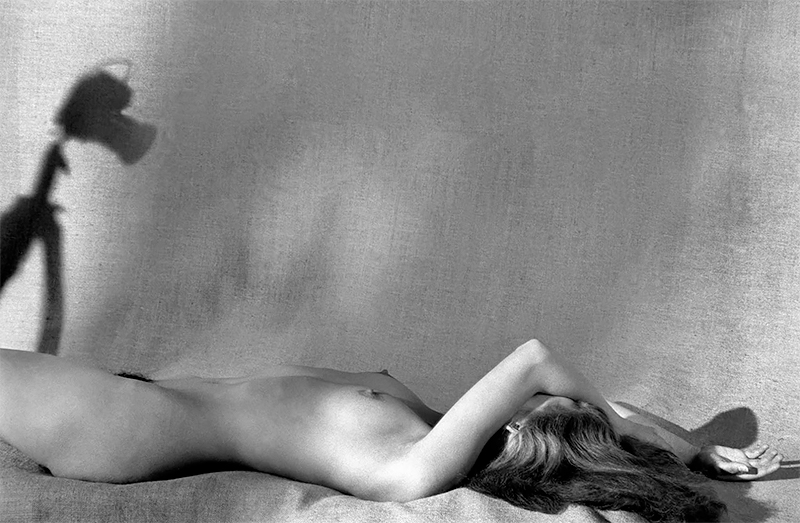
1981, Paris, ad for Kodak © Frank Horvat
Settled in Paris in the 1950s, he left a lasting mark on post-war photography with elegant and sensual fashion shots. From goddesses with plunging necklines to faces captured by doe-like eyes, and nude dancers with voluptuous breasts, Frank Horvat’s women have all been sublimated by his loving gaze.
Jeanloup Sieff (French 1933-2000)
Gaining renown as a fashion photographer and photojournalist, Jeanloup Sieff achieved recognition for his captivating black-and-white photographs marked by a blend of sensuality and gentleness. Over the course of his professional journey, he captured images of prominent models of his era, including figures like Twiggy and Jean Shrimpton, along with cinema luminaries like Gérard Depardieu and Charlotte Rampling. Notably, Sieff played a pivotal role in orchestrating a provocative campaign for the inaugural Yves Saint Laurent fragrance, showcasing a daring nude portrayal of the designer. His exploration of this photographic genre persisted, with a consistent commitment to enhancing the allure of the female form through exceptionally refined and tender compositions.
”All aspects of photography interest me and I feel for the female body the same curiosity and the same love as for a landscape, a face or anything else which interests me. In any case, the nude is a form of landscape. There are no reasons for my photographs, nor any rules; all depends on the mood of the moment, on the mood of the model.”
— Jeanloup Sieff
Lee Friedlander (American 1934)
Lee Friedlander
Lee Friedlander’s foray into one of photography’s enduring genres commenced serendipitously in the late 1970s. This unexpected journey unfolded when a fellow teacher at Rice University in Houston arranged a regular roster of nude models for students. Friedlander quickly discovered his preference for photographing the models in their own homes. Employing a creative approach, he ingeniously incorporated household items like bedside lamps, potted plants, and sofa fabrics to juxtapose against the models’ angular poses and the assertive framing of the overall composition.
Friedlander’s nude compositions unapologetically reveal every blemish and contour, celebrating the unique characteristics of each body. His use of flash serves to counterbalance this realism, introducing a softening effect that often extends the body’s shadow right up to its silhouette. Notably, Friedlander’s nude portraits of Madonna, highly coveted and commanding significant prices, propelled this series to become one of the photographer’s most recognized bodies of work. The collection eventually saw publication in 1991 under the imprint of Jonathan Cape.
Lucien Clergue (French 1934 – 2014)
Lucien Clergue
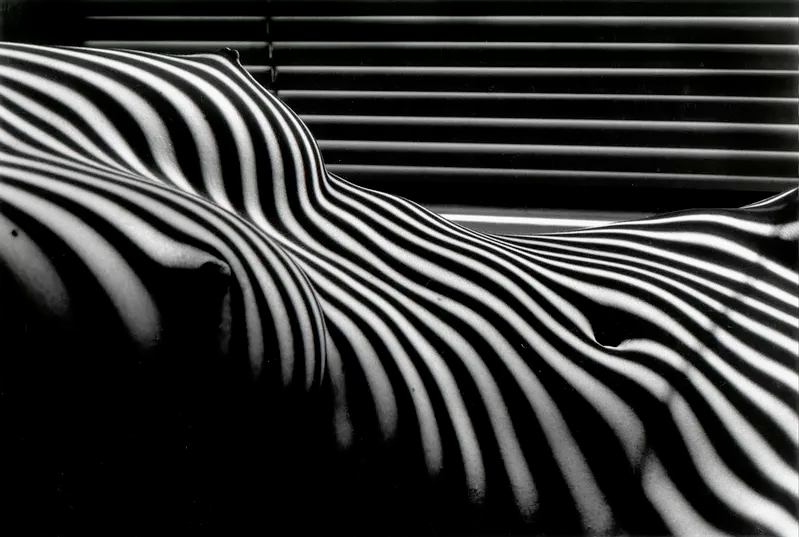
Nu Zebre, New York, 1997 © Lucien Clergue/Courtsy Trunk Archives
Arles saw the birth of Lucien Clergue in 1934, marking the initiation of his photographic journey at the youthful age of 15. Until his passing in 2014, he dedicated himself to the continuous documentation of his hometown. His photographic prowess not only left a lasting imprint but also secured him admission to the prestigious Academy of Fine Arts in 2006, a groundbreaking achievement for a photographer. Furthermore, Lucien Clergue played a pivotal role as the visionary behind the inception of the Arles Photography Encounters in 1968. Yet, his widespread acclaim is predominantly attributed to his captivating nude portraits of women. These evocative and organic compositions, devoid of facial features, have captivated global audiences with their sensuality, making Lucien Clergue a prominent figure in the realm of photography.
The inception occurs in 1957 when Lucien Clergue contributes illustrations to the compilation Corps mémorables, a poetic collection by Paul Eluard. In the collaboration, the artist joins forces with Pablo Picasso for the cover design and involves Jean Cocteau to provide an introductory poem. This publication showcases a sequence of monochromatic nude images, audacious enough to face censorship in Germany, leading the photographer to embark on a new series of captures. These photographs capture the essence of women’s bodies on the beach, within the Camargue, enveloped in gentle illumination and dynamic movement—an approach he would later continue in his career with subsequent series like Nus de la mer, Nées de la vague, or Les géantes.
What drove Lucien Clergue to delve into nude photography was the desire to exalt a perfect, happy body, the desire to exalt beauty. Jean Cocteau, in fact, declared about him: ”Clergue was undoubtedly the only witness to the birth of Aphrodite, let it be known.” The photographer added, ”When I photograph nudes, I push back the boundaries of death,” influenced by the sudden death of his mother when he was 19. To fulfill his project, he eliminates the faces of the women from the frame, thus giving his photos a universal dimension.
Beyond their visual allure, Lucien Clergue’s nude photographs echo the spirit of the 1960s, a period marked by the flourishing sexual revolution. The photographer, envisioning the body as a continuation of nature, consciously steers away from questionable eroticism. Instead, his approach is inherently organic: he instructs models to shed all makeup and jewelry, aiming to present the body as a celebration of the earth. In a 1983 INA archive, Lucien Clergue is observed guiding his models on the beach with ”human warmth, vitality,” deliberately avoiding any form of aggression to ensure that the woman is not objectified.
After venturing into nude photography within cityscapes, notably in New York, where he captured women in apartments overlooking skyscrapers, and amidst forests, where bodies interacted with trees and moss, Lucien Clergue immersed himself in the realm of striped nudes during the 1990s. Experimenting with the play of light through Venetian blinds, he produced images of sculptural bodies that resembled artworks, with light seamlessly intertwining with the skin. Despite the public’s fervor, he swiftly abandoned this approach, stating, ”In 1997, I captured an image of a woman with Venetian blinds. Right from the initial exhibition, it created a frenzy, with everyone eager to purchase that particular photo. Subsequently, I swiftly transitioned to something new. I always move forward rapidly, as I prefer not to find satisfaction in any particular motif. My sole authentic pleasure lies in the perfectly selfish and exhilarating experience of achieving a successful photograph. Everything else becomes insignificant.” The remainder becomes a part of history.
Jan Saudek (Czech 1935)
Jan Saudek
Jan Saudek, considered a prominent Czech photographer, is primarily renowned for his depictions of nudes and young individuals in dreamlike spaces. His hand-colored erotic photos of young women amidst painted backdrops and plaster accessories give his work the appearance of mid-19th-century snapshots. Born on May 13, 1935, in Prague, then part of Czechoslovakia, Saudek survived childhood captivity in a Nazi concentration camp, and art became a means of coping with haunting memories. He continued his interest in photography after encountering Edward Steichen’s book, The Family of Man. Despite the restrictions imposed by the communist regime in which he lived, Saudek became a globally recognized artist.
Ralph Gibson (American 1939)
Ralph Gibson
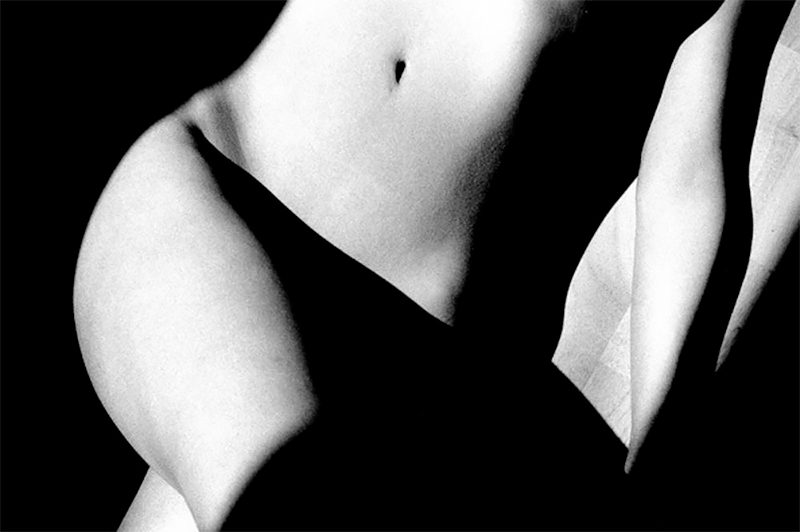
© Ralph Gibson
When asked why he likes nude photography he replied ”It’s magnetic. Since my first nude in San Francisco in 1961, I have been captivated. Most of the models are the women of my life! I am fascinated by the architectural details of the body; I feel humble before a woman’s body, but I don’t seek to hide behind it. At the risk of sounding arrogant, I have a broader range of subjects than my colleagues. In any case, like André Kertész, one of my mentors, I discover things to capture every day.”
Nobuyoshi Araki (Japanse 1940)
Nobuyoshi Araki
The woman’s body is his leitmotif: offered, mischievous, domestic, hunted; a kimono abandoned or fiercely entwined… Through this obsessive motif, he challenges all taboos of society, sex and death, despite the repeated censorship it faced. ”The world does not reveal itself as it really is. So, I started to reveal it from the female genitalia,” Araki likes to repeat.
His favorite themes are primarily Tokyo, the female body, the intimate and the mundane, and his production method involves wandering, daily life, and easy and unbridled triggering. Araki believes that photography is linked to sex and death, two impulses that, for him, are inseparable; nudity is in the portrait, not in the body. After the death of his wife in 1990, who was his muse, his work is punctuated by numerous photos of prostitutes, young nude students, and openly sexual scenes. In parallel, he photographs flowers, a metaphor for the female sex.
The woman holds a central position in Araki’s photographic universe, more than a muse; she is a kind of spiritual guide, a powerful and mysterious being that leads him on a quest for the essence of femininity, both carnal and abstract. He bares his subjects, binds them, transforms them into objects of desire capable of maintaining an independence as mysterious as it is elusive. Oscillating between modern frankness and ancient poetry, his photographs revive Japanese sexuality, an essential part of his perspective on the world. Whether capturing the iconic power of a woman’s body or a flower, finding the image of a face in the streets of Tokyo, or capturing the intensity of a black and white sky, each time he produces a reflection of himself.
Jean-Francois Jonvelle (French 1943 – 2002)
Jean-Francois Jonvelle
His reputation as a fashion photographer, particularly his shots of female models, reveals work imbued with deep sensuality and unabashed intimacy. He gazes upon his subjects with great respect, aiming to express a truth.
”When I photograph a woman, I want her to know that she is the most beautiful on earth because a woman who feels beautiful is truly the most beautiful woman in the world!” – Jean-Francois Jonvelle
He is a lover of women, capturing photos out of love and openly stating that his favorite subjects are the women he loves. In his images, they appear so beautiful that they seem timeless. His shots, spanning several decades, could have been taken yesterday, as if his photographs never age, frozen for eternity.
To maintain great mobility, he never uses flash or a tripod, relying solely on natural light. His preferred equipment is a reflex camera with an ultra-bright lens, either a 50mm f/1 or 85mm f/1.2. His models are often showcased in seemingly ordinary settings – a bedroom, a kitchen, a bathroom. Some are captured outdoors in various natural or urban environments. The surrounding elements play a fundamental role in his compositions, along with the framing, sometimes blurred due to the shallow depth of field resulting from the use of wide diaphragm openings. Daylight allows Jonvelle to sculpt his models with great naturalness, making his images more unsettling; it’s their fragility.
”I am a sentimental sexual obsessed, a born voyeur.” – Jean-François Jonvelle
For Jonvelle, certainty resides in a bathroom, a small apartment, or outdoors on a terrace. He photographs girls in his own universe, expressing domestic eroticism with always uncertain desires. When he shoots, he keeps his eye open 24×36 and a black and white iris.
”I am a happy photographer because I am always tracking women, watching them, loving them, trying to capture the emotions between desire and reality.”
— Jean-François Jonvelle
Robert Mapplethorpe (American 1946-1989)
Robert Mapplethorpe
Robert Mapplethorpe was an American photographer born into a Catholic family of Anglo-Irish origin, spent his childhood with his five siblings, a period he rarely discussed. At the age of 16, he enrolled in a visual arts school, the Pratt Institute in Brooklyn, initially specializing in sculpture before turning to photography. In the late 1960s, he became associated with Andy Warhol’s Factory.
Robert Mapplethorpe stands out as a prominent figure in the realm of post-war photography, known for crafting images characterized by a clean and precise style. Renowned for his distinctive black-and-white portraits of artists, as well as his captivating photographs of flowers and male and female nudes, he masterfully merges visual art and eroticism in a brutal chic manner. His undeniable talent initially garners recognition from the artistic circles of New York, patrons, and celebrities.
The explicit and sensual nature of the artworks from the midpoint of his career stirred controversies surrounding the public funding of art in the United States. Particularly, his photographs featuring male nudes sparked scandal for celebrating the beauty of gay sexuality. Robert Mapplethorpe’s photographic works prompt various inquiries, addressing topics such as the language of male nudity and its relationship with sexuality, the societal role and construction of gender and sexuality, the significance of form in contemporary art, and the challenges of censorship. Through a series of self-portraits, he candidly portrays his homosexuality, putting his exhibitions in New York at risk of censorship.
Influenced from the outset by photographers such as Horst P. Horst, Hoyningen-Huene, and Edward Weston, Robert Mapplethorpe’s artistic expression embodies a unique aesthetic reminiscent of Greek statues. He adopts an art deco vocabulary, a plastic artistry, and strategically places nudes against a neutral background to underscore their inherent essence.
Dominique Isserman (French 1947)
Dominique Isserman
Dominique Issermann is a French photographer. She works primarily with black and white photography, and is known for her works in portraits, fashion and advertising. She has shot campaigns for Sonia Rykiel, Christian Dior, Nina Ricci, Guess, Lancôme, La Perla, Tiffany, Chanel and many others.
Dominique Issermann’s artistic approach involves establishing a profoundly intimate connection between herself and the model. Her focus extends beyond the physical aspects, delving into the creation of illusions. Infusing a distinctive corporeal dimension, Issermann endeavors to imbue her characters with existential depth. This unique and specialized technique allows her to skillfully capture the essence of the moments lived by the models.
Dominique Issermann’s photographic focus revolves around the moments of connection between men and women. These instances, whether exuding seduction, dreaminess, or intense eroticism, are skillfully captured by the photographer, who possesses a distinctive perspective on romantic and sexual relationships. Recognizing the equality inherent in romantic connections, Issermann emphasizes that women are not mere passive objects of desire but rather sensual and autonomous individuals. These women transcend traditional roles as mere seductresses; instead, they exhibit control over their sexual impulses in every intimate relationship. It is this evident empowerment that elevates Issermann’s creations to a realm of extraordinary significance.
Paolo Roversi (Italian 1947)
Paolo Roversi
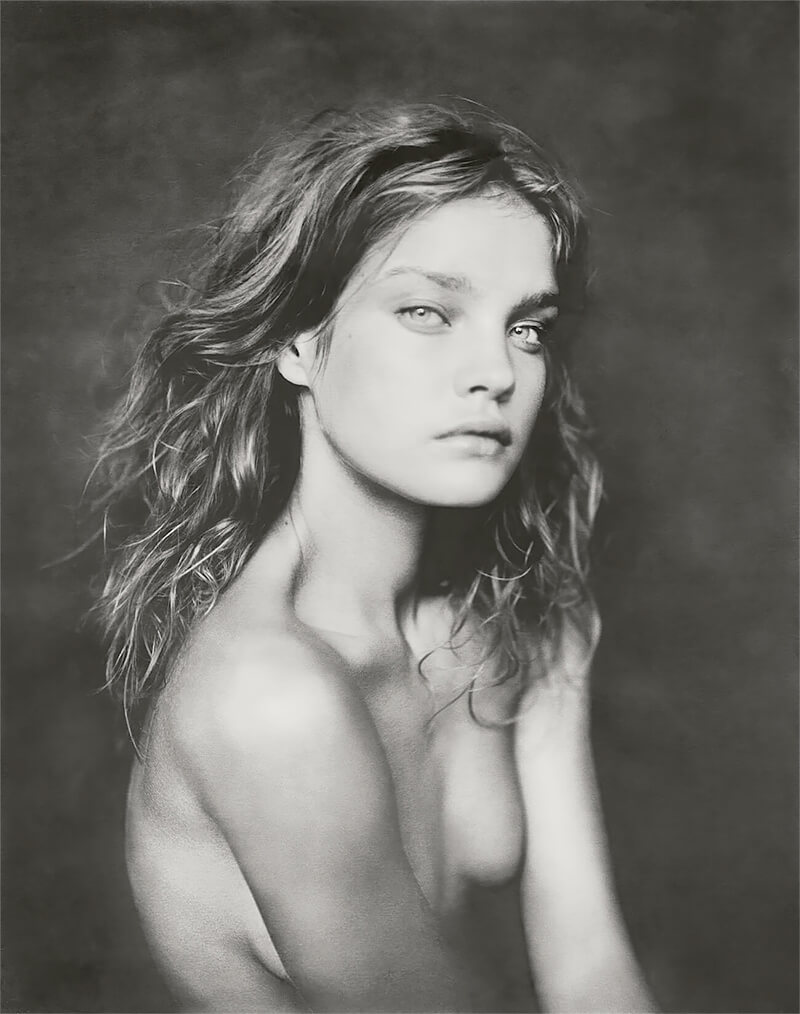
Natalia, Paris 2003 (for Egoïste) © Paolo Roversi, Courtesy Pace Gallery
Paolo Roversi stands out as a prominent figure in the realm of fashion photography. He skillfully imparts a distinctive and personal flair to the art of visual aesthetics, marked by a sense of intimacy. Employing a 20 x 25 cm Deardorf wooden view camera, Roversi employs a bellows – an essential black veil allowing the perception of the image in a ghostly and inverted form on the ground glass. This approach mirrors that of a 19th-century portraitist, albeit with the contemporary twist of utilizing Polaroid technology.
Reserved and unassuming, Paolo Roversi has dedicated more than four decades to crafting an artistic body of work that reflects an ongoing fascination with the delicate nature of beauty and the refined essence intrinsic to his interpretation of elegance. Drawing upon a rich background in the visual arts and a nuanced comprehension of photographic history, he achieves a nuanced portrayal of colors, a simplified yet stylized graphic aesthetic, and an unwavering exploration of novel forms that define the distinctive nature of his artistic prowess. His models, often exhibiting androgynous qualities, appear to draw inspiration from angelic myths reminiscent of a Pre-Raphaelite era, reimagined through a luminous, almost surreal light. This ethereal illumination imparts upon them an unexpected presence and vitality.
Sally Mann (American 1951)
Sally Mann
Her primary subjects encompass family members, close friends, and the surrounding natural environment, along with still lifes. Recently, she has delved into the exploration of death and decomposition in her still life compositions.
”I like to make people a little uncomfortable. It encourages them to examine who they are and why they think the way they do.”
— Sally Mann
She has gained recognition for her provocative body of work, notably the series Immediate Family, crafted between 1984 and 1991, where she transforms the genre of family photography. Revealing the intimate moments of everyday life featuring her son Emmet and daughters Jessie and Virginia, the series intertwines the innocence of childhood games with disquieting sensuality and a profound exploration of themes like death, violence, and life.
These fleeting childhood moments captured in photographs are as transient as our footprints on the sandy riverbank. Similarly, our family, marriage, children, and love—everything will fade away. Our only hope is that these photographs endure to narrate our brief tale. – Sally Mann
While her photographic work garners international acclaim, it also becomes a source of controversy in the latter half of the 1990s, facing allegations of exploiting her children.
Bettina Rheims (French 1952)
Bettina Rheims
Bettina Rheims, born Bettina Caroline Germaine Rheims is a French artist and photographer. She began her career with a series of images of striptease dancers and acrobats, and over the years she became one of the most notable persons behind the lens. I adore flesh. I am a skin photographer, she says famously, and that perfectly explains her work. It is raw and erotic, frequently involving nudity and stuffed animals, and she achieves a visceral emotion that captivates the audience.
Some of her most well-known pieces raise problems of gender, androgyny, and transsexuality. The women captured by Bettina Rheims exude nudity, provocation, and allure. They present themselves without surrender, epitomizing femme fatales while retaining an enigmatic aura within the photographer’s intricately complex and refined realm. Every photograph emerges from a thorough creative journey, and the images she crafts seem to emanate directly from her subconscious, brimming with allusions to art history, childhood fantasies, and surrealists like Marcel Duchamp..
”I still find myself having to justify being a woman taking pictures of naked women. It never occurred to me that there was something bizarre about it, it always felt very natural.”
— Bettina Rheims
Herb Ritts (American 1952 – 2002)
Herb Ritts
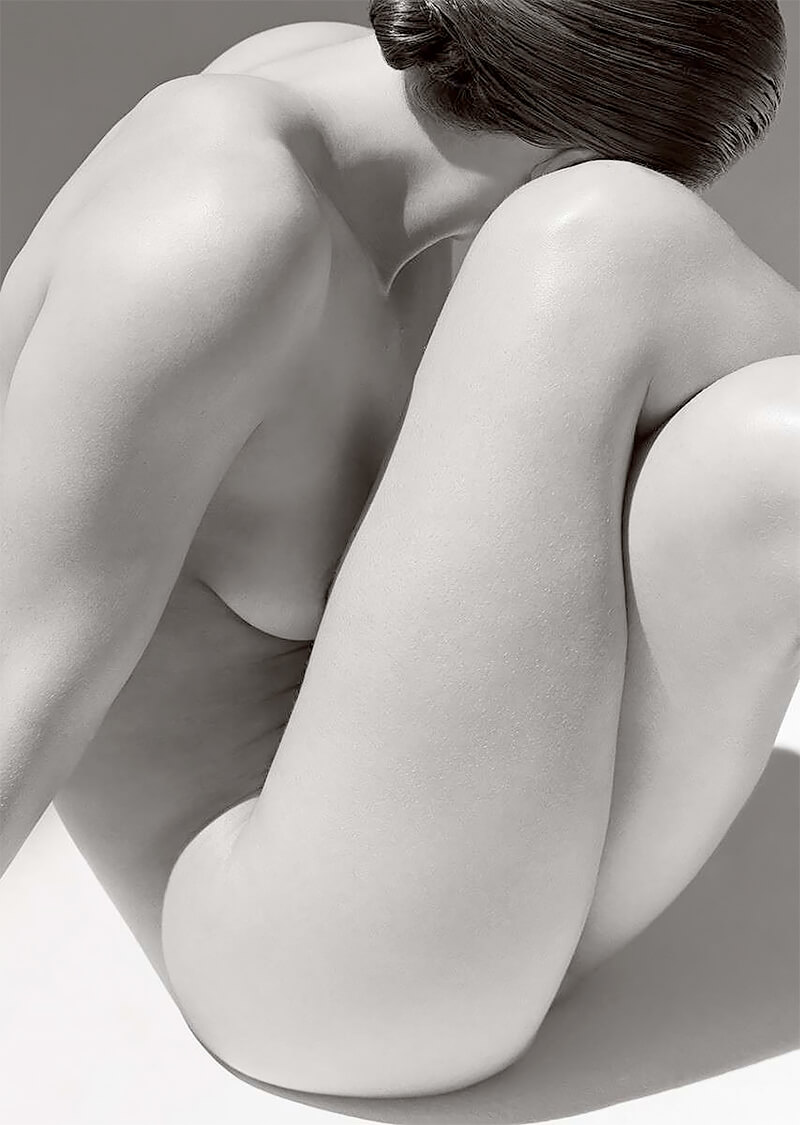
1997 MIami Tag Heuer Untitled Nude © Herb Ritts, Courtesy Trunk Archive
Herb Ritts began his photographic career in the late 70’s and gained a reputation as a master of art and commercial photography. In addition to producing portraits and editorial fashion for Vogue, Vanity Fair, Interview and Rolling Stone,
Herb Ritts’ photography is inherently authentic, constituting his distinctive approach. Demonstrating an equal attentiveness to both women and men, his images consistently honor the magnificence of the human body. His artistic vision has been influenced by the timeless examples of fashion and male seduction, ranging from Horst to List, Platt Lynes to Hoyningen-Huene. Preferring the outdoors over the studio, this self-taught photographer immersed himself in sessions while exploring the works of Man Ray and Brancusi over several years. Known for his meticulous model selection, he followed the path of the master Helmut Newton, expressing an affinity for people of color, encompassing both women and men, such as Naomi Campbell, who gracefully embraced diverse moods and dreams.
Insights into the world of homosexuals and masochistic practices were shared by Robert Mapplethorpe, influencing Ritts in the milieu he navigated. Ritts’ photographic creations exhibit exceptional sensitivity, featuring an accessible eroticism that harmoniously blends sensuality and allure while eschewing unnecessary excess. Confronting celebrities, he refined his artistic signature, employing a black-and-white medium of impeccable density to convey inner beauty. Herb Ritts was an ardent photography enthusiast, viewing his role as a stroke of luck in his life.
Nan Goldin (American 1953)
Nan Goldin
Beginning as a teenager in Boston during the 1960s and later in New York from the 1970s onward, Nan Goldin has captured profoundly personal, impromptu, intimate, and boundary-pushing photographs of her family, friends, and lovers. In 1979, she unveiled her initial slideshow in a New York City nightclub, and her vividly hued, snapshot-style images quickly gained recognition as a groundbreaking contribution to the realm of fine art photography. The evolving exhibition, named The Ballad of Sexual Dependency, expanded into a multimedia presentation lasting forty-five minutes, featuring over 900 photographs accompanied by a musical soundtrack. This extensive collection was later published as an acclaimed book.
Francesca Woodman (American 1958-1981)
Francesca Woodman
Francesca Woodman was an American photographer best known for her black and white pictures featuring herself and female models. Many of her photographs show young women who are nude, blurred (due to movement and long exposure times), merging with their surroundings, or whose faces are obscured.
David LaChapelle (American 1963)
David LaChapelle
The essence of his artistic expression lies in a realm of fiction and artifice, transcending the boundaries of reality. His creations are a tapestry of vibrant hues, sensuality, irony, and a spirit of desacralization, manifested through provocative and theatrical imagery interwoven with a distinctive touch of baroque mysticism. Enriched with references from the art world, the aesthetics of his work are grounded in the visual language of advertising. Employing human silhouettes with a deliberate avoidance of explicit content, he seeks to establish a necessary distance from the burdensome weight of reality. In unconventional settings like deteriorating structures, fast-food establishments, delivery rooms, offices, and butcher shops, his models assume poses that add an intriguing dimension to his artistic narrative.
”My pictures are about getting as far away from reality as possible. Dreams should be part of our everyday life.”
— David LaChapelle
John Rankin (British 1966)
John Rankin
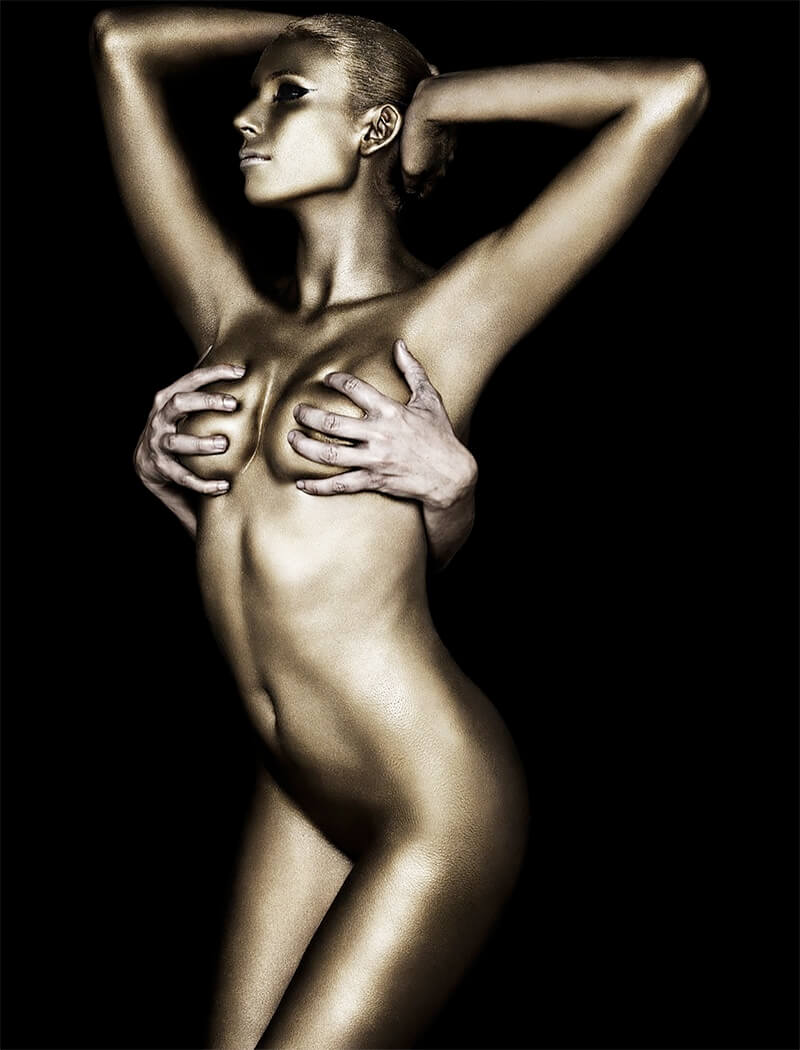
© Rankin
Rankin is recognized for his work in nude photography, capturing some of the most iconic nude images from the nineties and noughties, featuring supermodels like Kate Moss and Helena Christensen.
Throughout his professional journey, he has consistently revisited the theme of photographing the female form. Unapologetic, provocative, and beautiful, his book takes nude photography to new dimensions, daring yet intimate in its super-sized scale.
With a commitment to celebrating and empowering women, Rankin injects his nudes with a distinctive humor and cheek, crafting playful images that challenge societal expectations.
While the nude has long been an established artistic tradition, Rankin’s images delve into the realms of fun and taboo associated with revealing private nudity and sexuality. His photographs go beyond the conventional nude, aiming to uncover something more audacious and candid.
To Learn More Read A brief history of nude photography
Stay up-to-date with call for entries, deadlines and other news about exhibitions, galleries, publications, & special events.
source:- https://www.all-about-photo.com/photo-articles/photo-article/1030/masters-of-nude-photography





